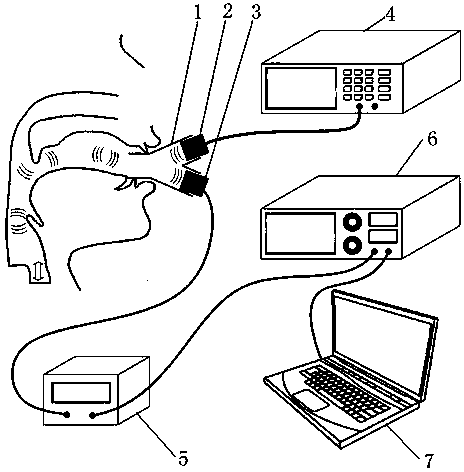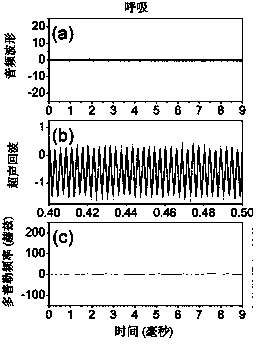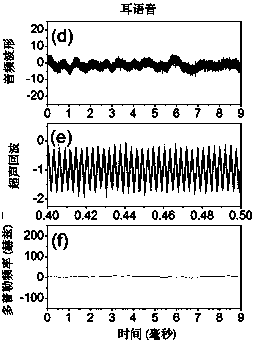Vocal-cord vibration nondestructive measurement method utilizing natural sound track ultraphonic waveguide effect
A technology of vocal cord vibration and measurement method, applied in ultrasonic/sonic/infrasonic diagnosis, ultrasonic/sonic/infrasonic Permian technology, ultrasonic/sonic/infrasonic image/data processing, etc., can solve problems such as limited application scope, Achieve the effect of simple measurement equipment, easy laryngeal function examination, high safety and ease of use
- Summary
- Abstract
- Description
- Claims
- Application Information
AI Technical Summary
Problems solved by technology
Method used
Image
Examples
Embodiment 1
[0041] like figure 2 As shown in the figure, the subject was asked to breathe into the port of the Y-shaped catheter, but not to make a sound. The signal generator generates a sinusoidal signal with a frequency of 350kHz, and an ultrasonic wave with a frequency of 350kHz is generated by an air ultrasonic transducer for emission. Guided by the Y-shaped catheter, the ultrasound is directed to the oral cavity. The ultrasonic echo is received by another receiving air ultrasonic transducer, amplified and sampled at a sampling frequency of 100MHz, and stored in the computer. After the ultrasonic echo signal is demodulated by Hilbert transform, the Doppler frequency can be obtained. In this silent situation, since the body belt does not vibrate, the ultrasonic reflective surface is a static surface. The Doppler frequency value obtained by the method of the present invention is also very small, according to the formula and , the velocity and displacement of vocal cord vibratio...
Embodiment 2
[0043] like image 3 As shown, the subject is required to utter the voice / a / to the port of the Y-shaped catheter, and the waveform of the voice signal is as follows figure 2 (d) shown. The signal generator generates a sinusoidal signal with a frequency of 350kHz, and an ultrasonic wave with a frequency of 350kHz is generated by an air ultrasonic transducer for emission. Guided by the Y-shaped catheter, the ultrasound is directed to the oral cavity. The ultrasonic echo is received by another receiving air ultrasonic transducer, amplified and sampled at a sampling frequency of 100MHz, and stored in the computer. After the ultrasonic echo signal is demodulated by Hilbert transform, the Doppler frequency can be obtained. The production of in-ear speech is only audible high-speed turbulent noise generated by squeezing the high-speed airflow through the glottis, and a non-periodic irregular speech produced by vocal tract modulation. The vocalization process of in-ear speech do...
Embodiment 3
[0045] like Figure 4 As shown, the subject is required to face the port of the Y-shaped catheter and pronounce the vowel / a / in a normal sounding manner. The signal generator generates a sine signal with a frequency of 350 kHz, and the air ultrasonic transducer for emission generates a frequency of 350kHz ultrasonic. Guided by the Y-shaped catheter, the ultrasound is directed to the oral cavity. The ultrasonic echo is received by another receiving air ultrasonic transducer, amplified and sampled at a sampling frequency of 100MHz, and stored in the computer. After the ultrasonic echo signal is demodulated by Hilbert transform, the Doppler frequency can be obtained.
[0046] The production of vowels is the result of the glottis being excited by the vibration of the body belt, which periodically vibrates during the vocalization of the vowel. It can be measured by adopting the method of the invention that, under the condition of normal vowel sounding, the ultrasonic signal ref...
PUM
 Login to View More
Login to View More Abstract
Description
Claims
Application Information
 Login to View More
Login to View More - R&D
- Intellectual Property
- Life Sciences
- Materials
- Tech Scout
- Unparalleled Data Quality
- Higher Quality Content
- 60% Fewer Hallucinations
Browse by: Latest US Patents, China's latest patents, Technical Efficacy Thesaurus, Application Domain, Technology Topic, Popular Technical Reports.
© 2025 PatSnap. All rights reserved.Legal|Privacy policy|Modern Slavery Act Transparency Statement|Sitemap|About US| Contact US: help@patsnap.com



